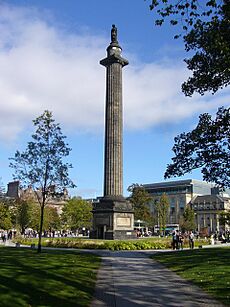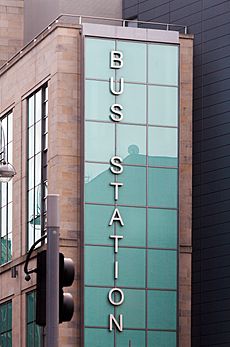St Andrew Square, Edinburgh facts for kids

View west over the square in 2008
|
|
| Type | Public square |
|---|---|
| Maintained by | Essential Edinburgh |
| Location | Edinburgh, Scotland, UK |
| Coordinates | 55°57′15″N 3°11′35″W / 55.95417°N 3.19306°W |
St Andrew Square is a beautiful garden square in Edinburgh, Scotland. You can find it at the east end of George Street. It's a busy and important spot in the city!
Building St Andrew Square started in 1772. It was the very first part of Edinburgh's New Town, which was designed by an architect named James Craig. In just six years, St Andrew Square became one of the most popular and stylish places to live in Edinburgh.
As the 1800s ended, the square changed. It became the main business centre of the city. Many big banks and insurance companies had their offices here. For a while, St Andrew Square was known as the richest area of its size in all of Scotland!
The gardens in the square are owned by private groups. They are part of the New Town Gardens collection. In 2008, the gardens were opened to everyone. They are now looked after by a group called Essential Edinburgh.
Today, the square has lots of shops. These include the famous department store Harvey Nichols. You can also find the fancy shopping area called Multrees Walk. There are also hotels like The Edinburgh Grand and many popular restaurants and cafes.
Contents
Exploring St Andrew Square
Melville Monument
Right in the middle of St Andrew Square, you'll see a tall, fluted column. This is the Melville Monument. It was built to remember Henry Dundas, who was a very important person. The monument is surrounded by the lovely St Andrew Square Gardens. These gardens were recently redesigned and are now open for everyone to enjoy.
Dundas House: A Grand Building

On the east side of the square stands a very impressive building called Dundas House. It was built by Sir William Chambers for Sir Lawrence Dundas between 1772 and 1774.
Dundas House was once meant to be the site for a church. However, in 1825, it became the main office for the Royal Bank of Scotland. If you look closely at the "Ilay" series of banknotes from the Royal Bank, you'll see parts of Dundas House! The front of the building is on the notes. Also, the star design on the notes comes from the beautiful ceiling inside the banking hall of Dundas House.
Hidden Tunnel Beneath the Square
Under the eastern part of the square, there's a long, old tunnel. It's called the Scotland Street Tunnel. This tunnel goes all the way under the New Town to another area called Canonmills. It was built in 1847 for a railway line. Part of its southern end was removed in the 1980s when a shopping centre was built.
Famous People Who Lived Here
Many famous Scots once lived in the homes around St Andrew Square.
- Lord Henry Brougham was born at No. 21 on the north side in 1778. His family was one of the first to live in the square.
- The famous thinker and economist David Hume also lived here. He was a friend of the architect Robert Adam. Adam convinced Hume to move from the Old Town to the New Town. Hume chose a spot on the southwest side of the square.
- Architect Sir William Chambers lived at No. 26 on the north side.
Getting Around: Transport Hub
St Andrew Square has been a major transport hub for many years. The original bus station was taken down in 2000. A new, modern one opened in 2003.
Buses
The Edinburgh Bus Station is just east of the square. It's where long-distance buses and coaches arrive and depart. Companies like Scottish Citylink and Stagecoach East Scotland use this station. Local bus services also have stops on the west side of the square.
Tram Stop
The St Andrew Square tram stop is right on the east side of the square. It's a very convenient stop!
- It's the closest tram stop for Edinburgh Waverley railway station, which is about 250 meters south.
- It's also very close to Edinburgh bus station, just 50 meters north.
Trams from this stop travel west through the city to Edinburgh Airport. They also go north to Leith and Newhaven.
| Preceding station | Edinburgh Trams | Following station | ||
|---|---|---|---|---|
| Picardy Place towards Newhaven |
Newhaven – Edinburgh Airport | Princes Street towards Airport |



